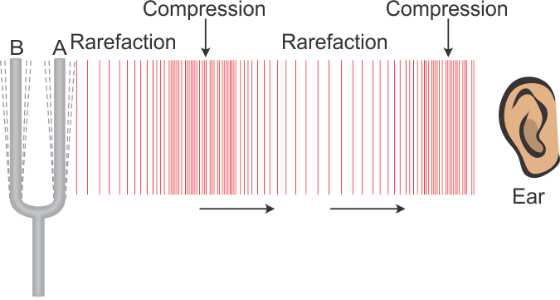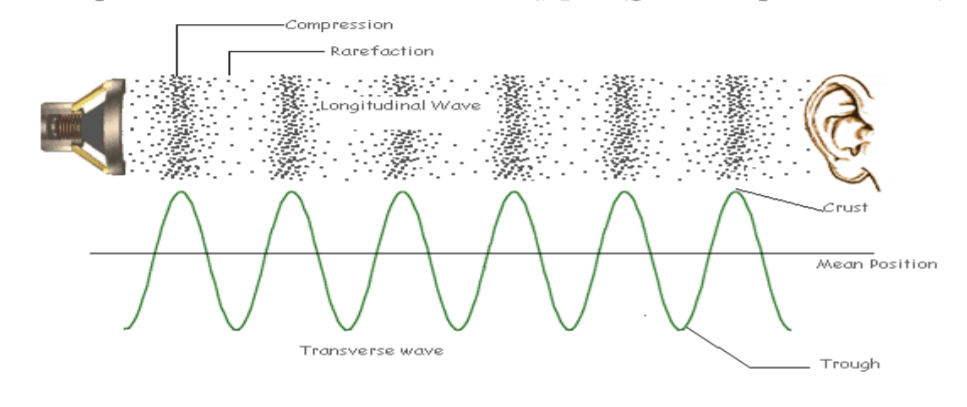Sound Study Guide
INTRODUCTION
It’s New Year’s Eve, and you’re off to the fireworks display in the city with your family. The clock hits midnight, and the whole crowd erupts in a cheer as they reach the end of their count down. The fireworks start with aerial shells shooting into the air, and as always, you see the flash and sparkly stars before hearing the “thuds”! Have you ever stopped to nerd out and ponder why it is that the sound always arrives a few seconds after the flash? If you’re thinking sound waves, then you are definitely headed in the right direction!
WHAT IS SOUND?
In physics, a sound wave is a vibration that propagates as mechanical waves through a medium. Sound can travel in solids, liquids, and gasses. It travels the fastest in solids and slowest in liquids. Sound waves are not too different from the ripples that form on a lake when you drop a stone into it. The energy travels outward in the form of a wave getting weaker the further it goes. Sound waves are similar, except they are 3-dimensional and travel outward like a bubble. The human ear is designed to detect the pressure of this bubble, and it is what we perceive as sound.
WHAT ARE SOUND WAVES?
A sound wave is a type of mechanical wave called a longitudinal wave. It is characterized by the wave’s energy propagating parallel to the direction of the vibrating particles. In the air, sound moves as a wave that generates continuous compression and rarefaction of gas molecules from the source to our ears.
When the tuning fork in the figure rings, it continuously transmits the vibration to the air molecules in its surroundings. This vibration gets passed on to adjacent air molecules in all directions as a wave with alternating high (compression) and low pressure (rarefaction). Our ears perceive sound by detecting the low and high-pressure periods that transmit the vibration to our eardrums.
Longitudinal waves which make up sound are different from transverse waves. In transverse waves, the propagation of energy is perpendicular to the direction of vibration of the particles. Waves on a stretched string and waves on the water are examples of transverse waves.
Since sound requires a medium to travel, it cannot travel in a vacuum such as space.
SPEED OF SOUND
Sound waves being longitudinal depend on the density and elastic property of the medium to travel faster or slower. Sound travels fastest in solids and slowest in gas. The molecules are tightly packed together in solids and transmit sound faster than liquids and gasses.
The speed of sound in air at sea level is about 346 m/s, whereas the speed of sound in Aluminum is 6,320 m/s! Going back to the fireworks display, sound travels a lot slower than light. Therefore, you always hear the sound after a few seconds of the flash.
CONCLUSION:
- A sound wave is a vibration that propagates as mechanical waves through a medium.
- Sound waves are longitudinal waves that travel as compression and rarefaction of air molecules.
- The speed of sound is different in different mediums.
FAQs:
1. What is sound?
Going by the sound definition in physics, it is a pressure wave generated by a vibrating object perceived by our ears.
2. What are the three types of sound?
Sound waves can be classified as longitudinal, mechanical, and pressure waves.
3. What is an example of sound?
Lightning, everyday sounds are coming from vehicles, birds, and speech.
We hope you enjoyed studying this lesson and learned something cool about Sound! Join our Discord community to get any questions you may have answered and to engage with other students just like you! Don’t forget to download our App to experience our fun, VR classrooms – we promise, it makes studying much more fun! 😎
SOURCES:
- 17.1 Sound Wave. https://flexbooks.ck12.org/cbook/ck-12-physics-flexbook-2.0/section/12.1/primary/lesson/sound-waves/. Accessed 28 Jan 2022.
- Types of Waves. https://byjus.com/physics/types-of-waves/. Accessed 28 Jan 2022.
- Are sound waves longitudinal waves or transverse waves?. https://www.tuttee.co/blog/phys-sound-waves. Accessed 28 Jan 2022.



